The UDS - Patient Status Report displays the total the number of patients who have completed procedures within a specified date range and who have specified statuses (race, language, poverty level, worker status, sexual orientation, homeless status, veteran status, ethnicity, religion, user-defined, housing status, and/or gender identity) attached to their Family File records. The report can also list patients on the report by ZIP Code (optionally sub-grouped by insurance carrier financial class) and display patient information for the patients on the report. This report uses the UDS (Uniform Data System) standards for reporting.
|
Why: |
To generate a record of patient statuses for UDS reporting for comparison with national data, and to provide patient and financial class statistics to grantees, partners, and communities |
When: |
As needed |
To generate the report
In DXOne Reporting, select UDS, and then double-click UDS - Patient Status.
The UDS - Patient Status dialog box appears.
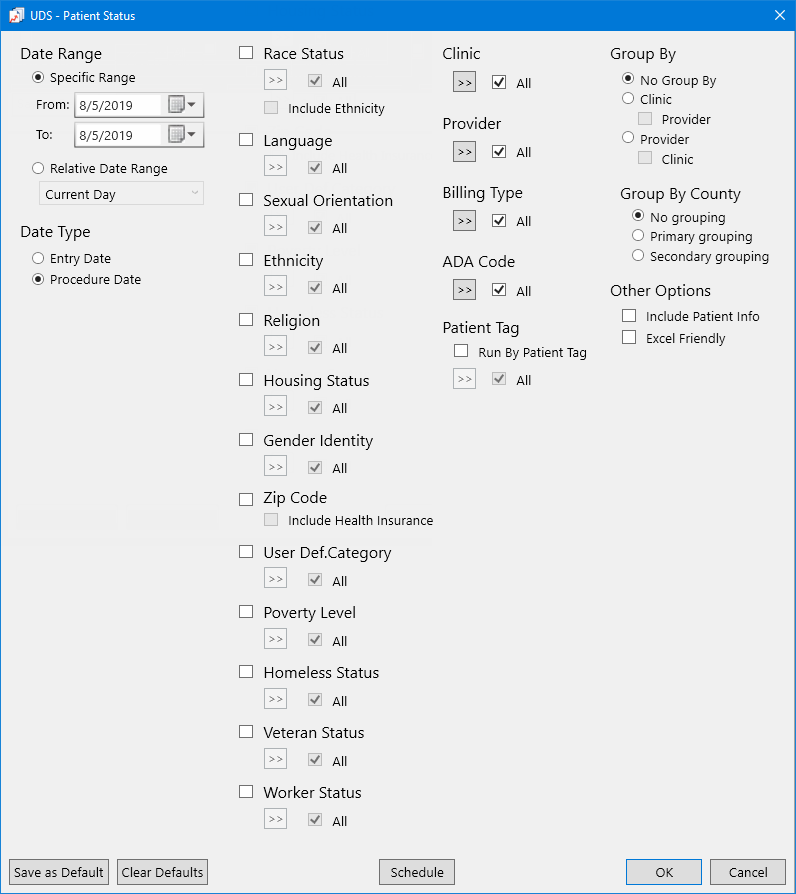
Set up the following options:
Date Range - To filter the report by date, do one of the following:
To include patients with procedures that have dates (based on the Date Type) within a range that you specify, select the Specific Range option. With this option selected, do one of the following:
Enter a date range (in a m/d/yyyy format) in the From and To boxes.
To select a date, do the following for From and To:
Click the corresponding calendar icon to view a month calendar.

Navigate to the correct month, using the left and right arrows.
Note: To quickly change the year and month, click the month-year at the top of the calendar, navigate to the correct year, using the left and right arrows, and then click the correct month.
Click the correct day.
To include patients with procedures that have dates (based on the Date Type) within a range that is relative to the report date, select the Relative Date Range option. With this option selected, select one of the following relative date ranges from the list:
Current Day Current MTD Current Fiscal YTD Current Calendar YTD |
Previous Day Previous Week Previous Month Previous 3 Months Previous 6 Months Previous Fiscal Year Previous Calendar Year |
Next Day Next Week Next Month Next 3 Months Next 6 Months Next Fiscal Year Next Calendar Year |
Date Type - Select one of the following options:
Entry Date - To include a procedure based on the date that it was created (entered into the database).
Procedure Date - To include a procedure based on the date that was specified for it.
Note: Most of the time, a procedure will have the same entry and procedure date. They will differ only if you backdate the procedure.
Race Status - Do one of the following:
To not include statistics for race statuses, clear the Race Status checkbox.
To include statistics for the race statuses that are assigned to patients who have procedures entered in their records, select the Race Status checkbox. With this checkbox selected, the options to select race statuses are available. Do one of the following:
To include patients with any race status, select the All checkbox.
To include patients with specific race statuses, do the following:
Click the search button ![]() .
.
The Select Race dialog box appears.
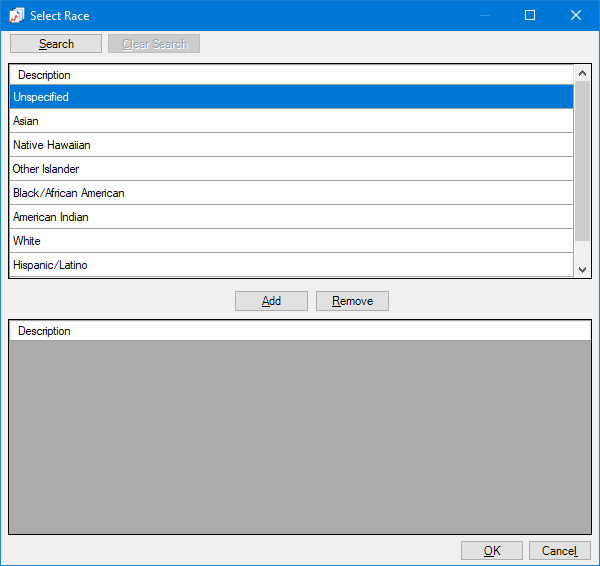
If the list is long, to search for a race status, do the following:
Click Search.
The options for searching appear in the upper list.

Enter the first character or more of a race status description in the Description box.
Click Show Results to view a list of matching race statuses.
Note: To return to viewing the list of all the race statuses, click Search, click Clear Search to clear the search criteria that you entered, and then click Show Results.
In the upper list, select one or more race statuses.
Note: To select multiple race statuses, click a race status, and then, while pressing the Ctrl key, click the other desired race statuses. To select a range of adjacent race statuses, click the first race status of the desired range of race statuses, and then, while pressing the Shift key, click the last race status of the desired range of race statuses.
Click Add.
Repeat steps b-d as needed to add other race statuses.
Note: To not include a race status that you added, select that race status in the lower list, and then click Remove.
Click OK.
Under Race Status, do one of the following:
To include statistics for each ethnicity under each specified race for the report, select the Include Ethnicity check box.
To not include statistics for each ethnicity under each specified race for the report, clear the Include Ethnicity checkbox.
Note: The Include Ethnicity checkbox is available only the Race Status checkbox is selected.
Language - Do one of the following:
To not include statistics for languages, clear the Language checkbox.
To include statistics for the languages that are assigned to patients who have procedures entered in their records, select the Language checkbox. With this checkbox selected, the options to select languages are available. Do one of the following:
To include patients with any language, select the All checkbox.
To include patients with specific languages, do the following:
Click the search button ![]() .
.
The Select Language dialog box appears.
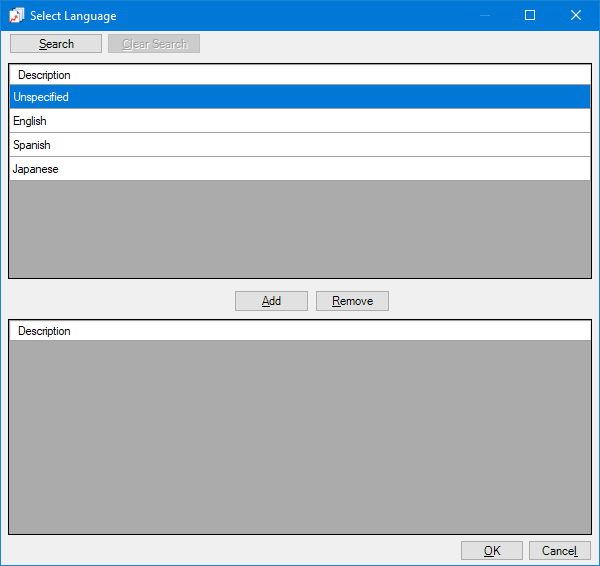
If the list is long, to search for a language, do the following:
Click Search.
The options for searching appear in the upper list.

Enter the first character or more of a language description in the Description box.
Click Show Results to view a list of matching languages.
Note: To return to viewing the list of all the languages, click Search, click Clear Search to clear the search criteria that you entered, and then click Show Results.
In the upper list, select one or more languages.
Note: To select multiple languages, click a language, and then, while pressing the Ctrl key, click the other desired languages. To select a range of adjacent languages, click the first language of the desired range of languages, and then, while pressing the Shift key, click the last language of the desired range of languages.
Click Add.
Repeat steps b-d as needed to add other languages.
Note: To not include a language that you added, select that language in the lower list, and then click Remove.
Click OK.
Sexual Orientation - Do one of the following:
To not include statistics for sexual orientations, clear the Sexual Orientation checkbox.
To include statistics for the sexual orientations that are assigned to patients who have procedures entered in their records, select the Sexual Orientation checkbox. With this checkbox selected, the options to select sexual orientations are available. Do one of the following:
To include patients with any sexual orientation, select the All checkbox.
To include patients with specific sexual orientations, do the following:
Click the search button ![]() .
.
The Select Sexual Orientation dialog box appears.
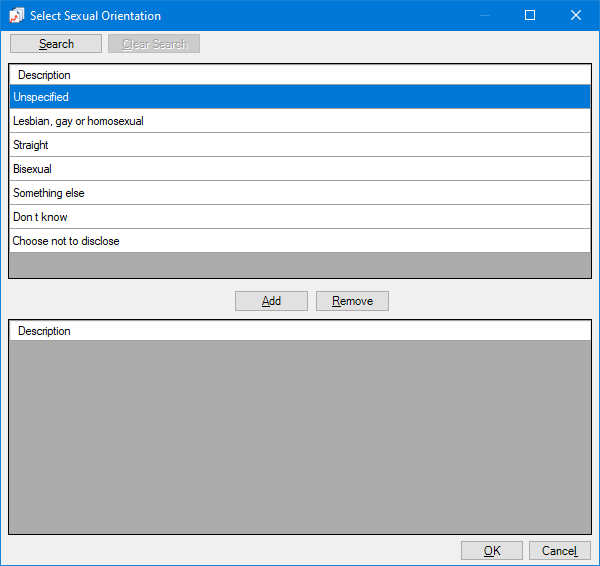
If the list is long, to search for a sexual orientation, do the following:
Click Search.
The options for searching appear in the upper list.

Enter the first character or more of a sexual orientation description in the Description box.
Click Show Results to view a list of matching sexual orientations.
Note: To return to viewing the list of all the sexual orientations, click Search, click Clear Search to clear the search criteria that you entered, and then click Show Results.
In the upper list, select one or more sexual orientations.
Note: To select multiple sexual orientations, click a sexual orientation, and then, while pressing the Ctrl key, click the other desired sexual orientations. To select a range of adjacent sexual orientations, click the first sexual orientation of the desired range of sexual orientations, and then, while pressing the Shift key, click the last sexual orientation of the desired range of sexual orientations.
Click Add.
Repeat steps b-d as needed to add other sexual orientations.
Note: To not include a sexual orientation that you added, select that sexual orientation in the lower list, and then click Remove.
Click OK.
Ethnicity - Do one of the following:
To not include statistics for ethnicities, clear the Ethnicity checkbox.
To include statistics for the ethnicities that are assigned to patients who have procedures entered in their records, select the Ethnicity checkbox. With this checkbox selected, the options to select ethnicities are available. Do one of the following:
To include patients with any ethnicity, select the All checkbox.
To include patients with specific ethnicities, do the following:
Click the search button ![]() .
.
The Select Ethnicity dialog box appears.
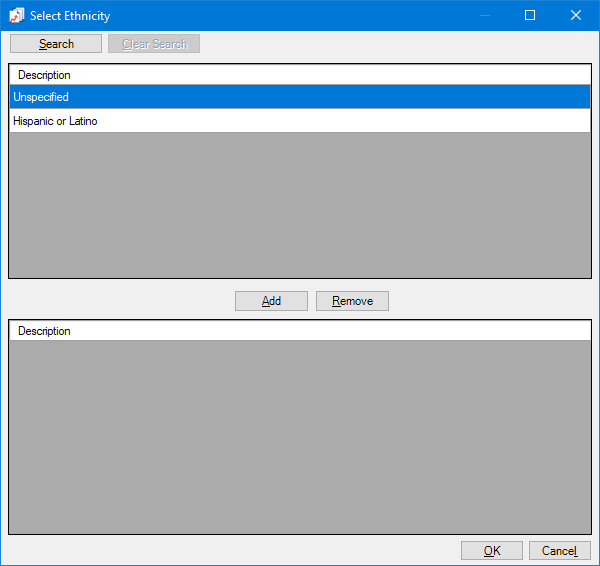
If the list is long, to search for an ethnicity, do the following:
Click Search.
The options for searching appear in the upper list.

Enter the first character or more of an ethnicity description in the Description box.
Click Show Results to view a list of matching ethnicities.
Note: To return to viewing the list of all the ethnicities, click Search, click Clear Search to clear the search criteria that you entered, and then click Show Results.
In the upper list, select one or more ethnicities.
Note: To select multiple ethnicities, click an ethnicity, and then, while pressing the Ctrl key, click the other desired ethnicities. To select a range of adjacent ethnicities, click the first ethnicity of the desired range of ethnicities, and then, while pressing the Shift key, click the last ethnicity of the desired range of ethnicities.
Click Add.
Repeat steps b-d as needed to add other ethnicities.
Note: To not include an ethnicity that you added, select that ethnicity in the lower list, and then click Remove.
Click OK.
Religion - Do one of the following:
To not include statistics for religions, clear the Religion checkbox.
To include statistics for the religions that are assigned to patients who have procedures entered in their records, select the Religion checkbox. With this checkbox selected, the options to select religions are available. Do one of the following:
To include patients with any religion, select the All checkbox.
To include patients with specific religions, do the following:
Click the search button ![]() .
.
The Select Religion dialog box appears.
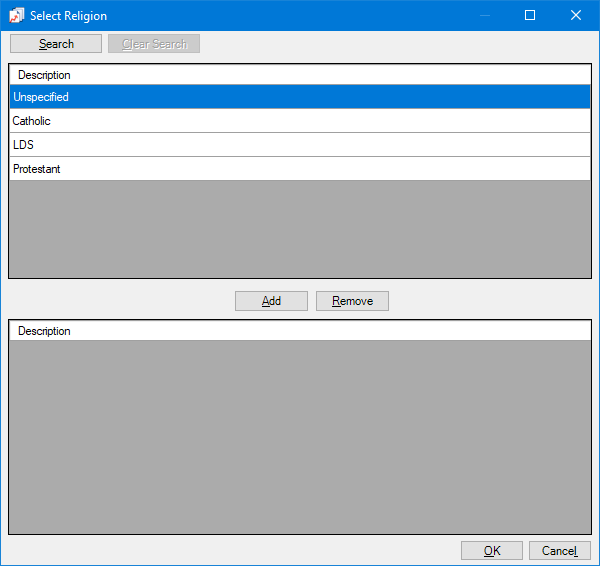
If the list is long, to search for a religion, do the following:
Click Search.
The options for searching appear in the upper list.

Enter the first character or more of a religion description in the Description box.
Click Show Results to view a list of matching religions.
Note: To return to viewing the list of all the religions, click Search, click Clear Search to clear the search criteria that you entered, and then click Show Results.
In the upper list, select one or more religions.
Note: To select multiple religions, click a religion, and then, while pressing the Ctrl key, click the other desired religions. To select a range of adjacent religions, click the first religion of the desired range of religions, and then, while pressing the Shift key, click the last religion of the desired range of religions.
Click Add.
Repeat steps b-d as needed to add other religions.
Note: To not include a religion that you added, select that religion in the lower list, and then click Remove.
Click OK.
Housing Status - Do one of the following:
To not include statistics for housing statuses, clear the Housing Status checkbox.
To include statistics for the housing statuses that are assigned to patients who have procedures entered in their records, select the Housing Status checkbox. With this checkbox selected, the options to select housing statuses are available. Do one of the following:
To include patients with any housing status, select the All checkbox.
To include patients with specific housing statuses, do the following:
Click the search button ![]() .
.
The Select Housing Status dialog box appears.
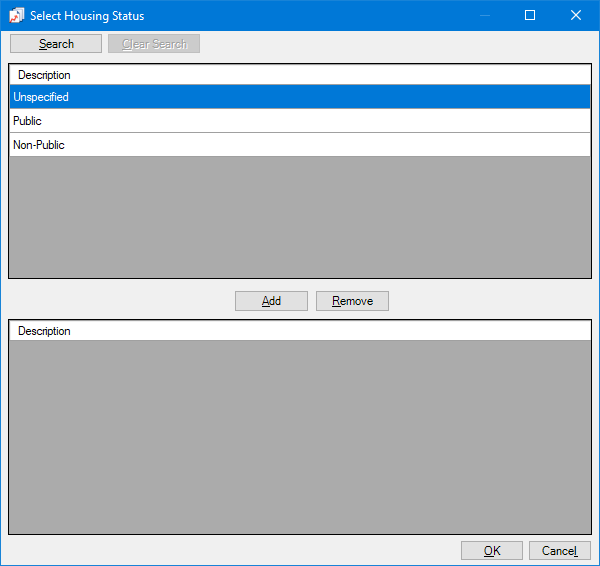
If the list is long, to search for a housing status, do the following:
Click Search.
The options for searching appear in the upper list.

Enter the first character or more of a housing status description in the Description box.
Click Show Results to view a list of matching housing statuses.
Note: To return to viewing the list of all the housing statuses, click Search, click Clear Search to clear the search criteria that you entered, and then click Show Results.
In the upper list, select one or more housing statuses.
Note: To select multiple housing statuses, click a housing status, and then, while pressing the Ctrl key, click the other desired housing statuses. To select a range of adjacent housing statuses, click the first housing status of the desired range of housing statuses, and then, while pressing the Shift key, click the last housing status of the desired range of housing statuses.
Click Add.
Repeat steps b-d as needed to add other housing statuses.
Note: To not include a housing status that you added, select that housing status in the lower list, and then click Remove.
Click OK.
Gender Identity - Do one of the following:
To not include statistics for gender identities, clear the Gender Identity checkbox.
To include statistics for the gender identities that are assigned to patients who have procedures entered in their records, select the Gender Identity checkbox. With this checkbox selected, the options to select gender identities are available. Do one of the following:
To include patients with any gender identity, select the All checkbox.
To include patients with specific gender identities, do the following:
Click the search button ![]() .
.
The Select Gender Identity dialog box appears.
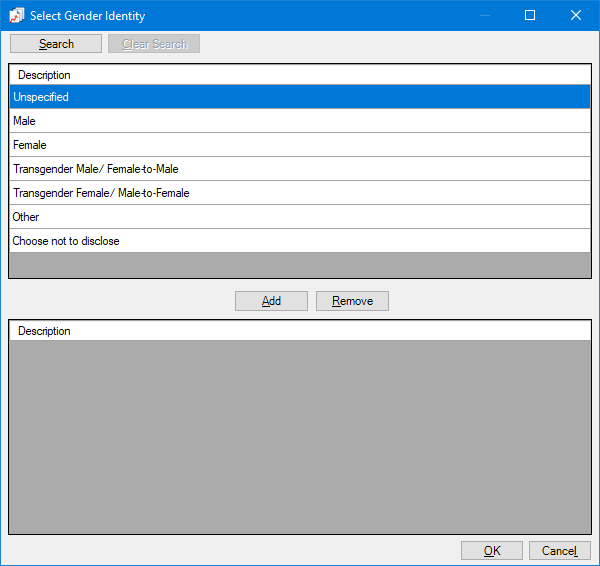
If the list is long, to search for a gender identity, do the following:
Click Search.
The options for searching appear in the upper list.

Enter the first character or more of a gender identity description in the Description box.
Click Show Results to view a list of matching gender identities.
Note: To return to viewing the list of all the gender identities, click Search, click Clear Search to clear the search criteria that you entered, and then click Show Results.
In the upper list, select one or more gender identities.
Note: To select multiple gender identities, click a gender identity, and then, while pressing the Ctrl key, click the other desired gender identities. To select a range of adjacent gender identities, click the first gender identity of the desired range of gender identities, and then, while pressing the Shift key, click the last gender identity of the desired range of gender identities.
Click Add.
Repeat steps b-d as needed to add other gender identities.
Note: To not include a gender identity that you added, select that gender identity in the lower list, and then click Remove.
Click OK.
Zip Code - Do one of the following:
To not include a list of patients that live in each ZIP Code, clear the Race Status checkbox.
To include a list of patients that live in each ZIP Code, select the Zip Code checkbox. With this checkbox selected, do one of the following:
To include statistics for each type of insurance coverage (such as uninsured, private, and Medicaid), select the Include Health Insurance checkbox.
To not include statistics for each type of insurance coverage (such as uninsured, private, and Medicaid), clear the Include Health Insurance checkbox.
Note: The Include Health Insurance check box is available only the Zip Code checkbox is selected.
User Def. Category - Do one of the following:
To not include statistics for user-defined statuses, clear the User Def. Category checkbox.
To include statistics for the user-defined statuses that are assigned to patients who have procedures entered in their records, select the User Def. Category checkbox. With this checkbox selected, the options to select languages are available. Do one of the following:
To include patients with any user-defined status, select the All checkbox.
To include patients with specific user-defined statuses, do the following:
Click the search button ![]() .
.
The Select User Defined dialog box appears.
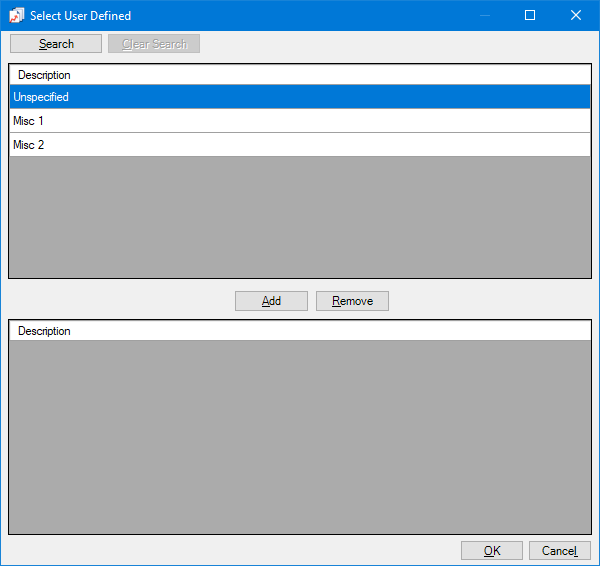
If the list is long, to search for a user-defined status, do the following:
Click Search.
The options for searching appear in the upper list.

Enter the first character or more of a user-defined status description in the Description box.
Click Show Results to view a list of matching user-defined statuses.
Note: To return to viewing the list of all the user-defined statuses, click Search, click Clear Search to clear the search criteria that you entered, and then click Show Results.
In the upper list, select one or more user-defined statuses.
Note: To select multiple user-defined statuses, click a user-defined status, and then, while pressing the Ctrl key, click the other desired user-defined statuses. To select a range of adjacent user-defined statuses, click the first user-defined status of the desired range of user-defined statuses, and then, while pressing the Shift key, click the last user-defined status of the desired range of user-defined statuses.
Click Add.
Repeat steps b-d as needed to add other user-defined statuses.
Note: To not include a user-defined status that you added, select that user-defined status in the lower list, and then click Remove.
Click OK.
Poverty Level - Do one of the following:
To not include statistics for poverty levels, clear the Poverty Level checkbox.
To include statistics for the poverty levels that are assigned to patients who have procedures entered in their records, select the Poverty Level checkbox. With this checkbox selected, the options to select poverty levels are available. Do one of the following:
To include patients with any poverty level, select the All checkbox.
To include patients with specific poverty levels, do the following:
Click the search button ![]() .
.
The Select Poverty Level dialog box appears.
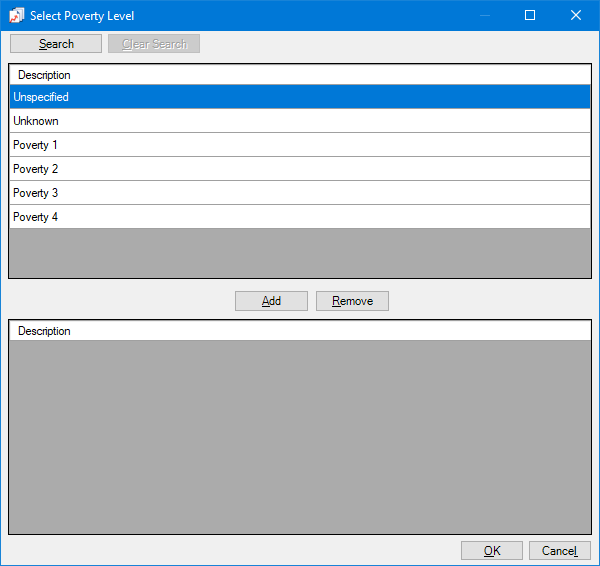
If the list is long, to search for a poverty level, do the following:
Click Search.
The options for searching appear in the upper list.

Enter the first character or more of a poverty level description in the Description box.
Click Show Results to view a list of matching poverty levels.
Note: To return to viewing the list of all the poverty levels, click Search, click Clear Search to clear the search criteria that you entered, and then click Show Results.
In the upper list, select one or more poverty levels.
Note: To select multiple poverty levels, click a poverty level, and then, while pressing the Ctrl key, click the other desired poverty levels. To select a range of adjacent poverty levels, click the first poverty level of the desired range of poverty levels, and then, while pressing the Shift key, click the last poverty level of the desired range of poverty levels.
Click Add.
Repeat steps b-d as needed to add other poverty levels.
Note: To not include a poverty level that you added, select that poverty level in the lower list, and then click Remove.
Click OK.
Homeless Status - Do one of the following:
To not include statistics for homeless statuses, clear the Homeless Status checkbox.
To include statistics for the homeless statuses that are assigned to patients who have procedures entered in their records, select the Homeless Status checkbox. With this checkbox selected, the options to select homeless statuses are available. Do one of the following:
To include patients with any homeless status, select the All checkbox.
To include patients with specific homeless statuses, do the following:
Click the search button ![]() .
.
The Select Homeless Status dialog box appears.

If the list is long, to search for a homeless status, do the following:
Click Search.
The options for searching appear in the upper list.

Enter the first character or more of a homeless status description in the Description box.
Click Show Results to view a list of matching homeless statuses.
Note: To return to viewing the list of all the homeless statuses, click Search, click Clear Search to clear the search criteria that you entered, and then click Show Results.
In the upper list, select one or more homeless statuses.
Note: To select multiple homeless statuses, click a homeless status, and then, while pressing the Ctrl key, click the other desired homeless statuses. To select a range of adjacent homeless statuses, click the first homeless status of the desired range of homeless statuses, and then, while pressing the Shift key, click the last homeless status of the desired range of homeless statuses.
Click Add.
Repeat steps b-d as needed to add other homeless statuses.
Note: To not include a homeless status that you added, select that homeless status in the lower list, and then click Remove.
Click OK.
Veteran Status - Do one of the following:
To not include statistics for veteran statuses, clear the Veteran Status checkbox.
To include statistics for the veteran statuses that are assigned to patients who have procedures entered in their records, select the Veteran Status checkbox. With this checkbox selected, the options to select veteran statuses are available. Do one of the following:
To include patients with any veteran status, select the All checkbox.
To include patients with specific veteran statuses, do the following:
Click the search button ![]() .
.
The Select Veteran Status dialog box appears.
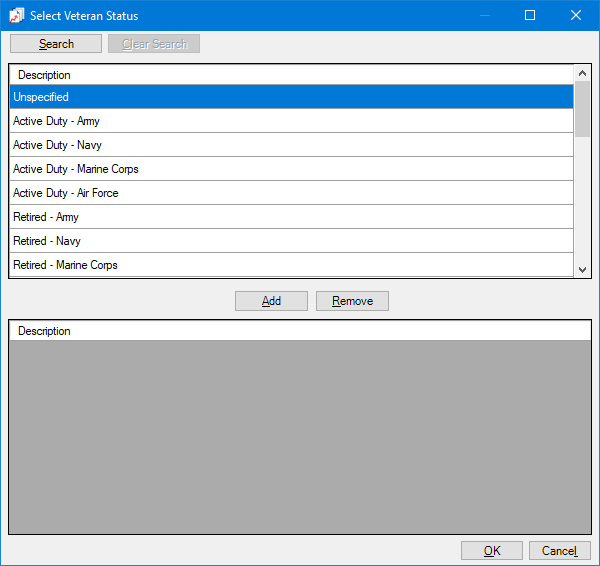
If the list is long, to search for a veteran status, do the following:
Click Search.
The options for searching appear in the upper list.

Enter the first character or more of a veteran status description in the Description box.
Click Show Results to view a list of matching veteran statuses.
Note: To return to viewing the list of all the veteran statuses, click Search, click Clear Search to clear the search criteria that you entered, and then click Show Results.
In the upper list, select one or more veteran statuses.
Note: To select multiple veteran statuses, click a veteran status, and then, while pressing the Ctrl key, click the other desired veteran statuses. To select a range of adjacent veteran statuses, click the first veteran status of the desired range of veteran statuses, and then, while pressing the Shift key, click the last veteran status of the desired range of veteran statuses.
Click Add.
Repeat steps b-d as needed to add other veteran statuses.
Note: To not include a veteran status that you added, select that veteran status in the lower list, and then click Remove.
Click OK.
Worker Status - Do one of the following:
To not include statistics for worker statuses, clear the Worker Status checkbox.
To include statistics for the worker statuses that are assigned to patients who have procedures entered in their records, select the Worker Status checkbox. With this checkbox selected, the options to select worker statuses are available. Do one of the following:
To include patients with any worker status, select the All checkbox.
To include patient with specific worker statuses, do the following:
Click the search button ![]() .
.
The Select Worker Status dialog box appears.

If the list is long, to search for a worker status, do the following:
Click Search.
The options for searching appear in the upper list.

Enter the first character or more of a worker status description in the Description box.
Click Show Results to view a list of matching worker statuses.
Note: To return to viewing the list of all the worker statuses, click Search, click Clear Search to clear the search criteria that you entered, and then click Show Results.
In the upper list, select one or more worker statuses.
Note: To select multiple worker statuses, click a worker status, and then, while pressing the Ctrl key, click the other desired worker statuses. To select a range of adjacent worker statuses, click the first worker status of the desired range of worker statuses, and then, while pressing the Shift key, click the last worker status of the desired range of worker statuses.
Click Add.
Repeat steps b-d as needed to add other worker statuses.
Note: To not include a worker status that you added, select that worker status in the lower list, and then click Remove.
Click OK.
Clinic - To filter the report by the clinics that are associated with procedures, do one of the following:
To include all clinics that you are allowed to generate the report for, select the All checkbox.
To include specific clinics, do the following:
Click the search button  .
.
The Select Clinics dialog box appears.

Note: Only the clinics that you are allowed to generate the report for are available.
If the list is long, to search for a clinic by ID and/or title, do the following:
Click Search.
The options for searching appear in the upper list.

Enter the first character or more of a clinic's ID and/or title in the ID and Practice Title boxes, respectively.
Click Show Results to view a list of matching clinics.
Note: To return to viewing the list of all the clinics, click Search, click Clear Search to clear the search criteria that you entered, and then click Show Results.
In the upper list, select one or more clinics.
Note: To select multiple clinics, click a clinic, and then, while pressing the Ctrl key, click the other desired clinics. To select a range of adjacent clinics, click the first clinic of the desired range of clinics, and then, while pressing the Shift key, click the last clinic of the desired range of clinics.
Click Add.
Repeat steps b-d as needed to add other clinics.
Note: To not include a clinic that you added, select that clinic in the lower list, and then click Remove.
Click OK.
Provider - To filter the report by the providers that are associated with procedures, do one of the following:
To include all providers that you are allowed to generate the report for, select the All checkbox.
To include specific providers, do the following:
Click the search button  .
.
The Select Providers dialog box appears.
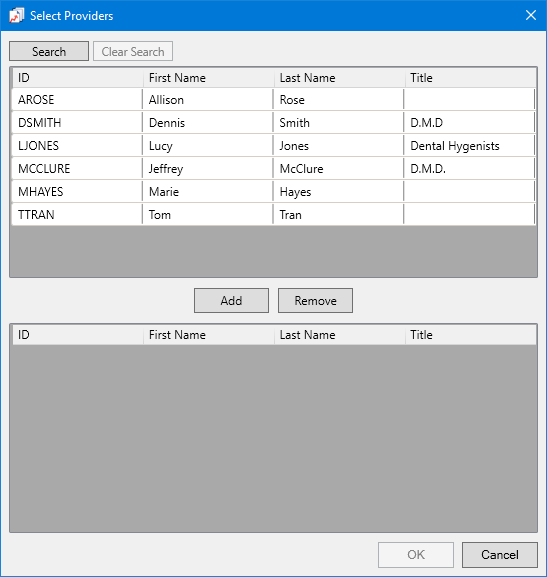
Note: Only the providers that you are allowed to generate the report for are available.
If the list is long, to search for a provider by ID, first name, last name, and/or title, do the following:
Click Search.
The options for searching appear in the upper list.

Enter the first character or more of a provider's ID, first name, last name, and/or title in the ID, First Name, Last Name, and Title boxes, respectively.
Click Show Results to view a list of matching providers.
Note: To return to viewing the list of all the providers, click Search, click Clear Search to clear the search criteria that you entered, and then click Show Results.
In the upper list, select one or more providers.
Note: To select multiple providers, click a provider, and then, while pressing the Ctrl key, click the other desired providers. To select a range of adjacent providers, click the first provider of the desired range of providers, and then, while pressing the Shift key, click the last provider of the desired range of providers.
Click Add.
Repeat steps b-d as needed to add other providers.
Note: To not include a provider that you added, select that provider in the lower list, and then click Remove.
Click OK.
Billing Type - To filter the report by the billing types that are associated with patients who have procedures entered in their records, do one of the following:
To include all billing types, select the All checkbox.
To include specific billing types, do the following:
Click the search button  .
.
The Select Billing Type dialog box appears.

If the list is long, to search for a billing type by ID and/or description, do the following:
Click Search.
The options for searching appear in the upper list.

Enter the first character or more of a billing type's ID and/or description in the ID and Description boxes, respectively.
Click Show Results to view a list of matching billing types.
Note: To return to viewing the list of all the billing types, click Search, click Clear Search to clear the search criteria that you entered, and then click Show Results.
In the upper list, select one or more billing types.
Note: To select multiple billing types, click a billing type, and then, while pressing the Ctrl key, click the other desired billing types. To select a range of adjacent billing types, click the first billing type of the desired range of billing types, and then, while pressing the Shift key, click the last billing type of the desired range of billing types.
Click Add.
Repeat steps b-d as needed to add other billing types.
Note: To not include a billing type that you added, select that billing type in the lower list, and then click Remove.
Click OK.
ADA Code - To filter the report by the procedures that have been entered into patient records, do one of the following:
To include all procedure codes, select the All checkbox.
To include specific procedure codes, do the following:
Click the search button  .
.
The Select ADA Codes dialog box appears.

Do one of the following:
To get a list of all procedure codes, do not enter any search criteria.
To search for procedure codes by category, abbreviated description, ADA code, and/or description, enter the first character or more of a procedure code category, abbreviated description, ADA code, and/or ADA description in the Category, User Code, ADA Code, and/or Description boxes, respectively.

Click Show Results to view a list of matching procedure codes.

Note: To clear the search criteria that you entered so you can search again, click Search, and then click Clear Search. Then, repeat steps b-c.
In the upper list, select one or more procedure codes.
Note: To select multiple procedure codes, click a procedure code, and then, while pressing the Ctrl key, click the other desired procedure codes. To select a range of adjacent procedure codes, click the first procedure code of the desired range of procedure codes, and then, while pressing the Shift key, click the last procedure code of the desired range of procedure codes.
Click Add.
Repeat steps b-e as needed to add other procedure codes.
Note: To not include a procedure code that you added, select that procedure code in the lower list, and then click Remove.
Click OK.
Patient Tag - Do one of the following:
To not filter the report by a patient tag, clear the Run By Patient Tag checkbox.
To filter the report by the tags that are assigned to patients who have procedures entered in their records, select the Run By Patient Tag checkbox. With this checkbox selected, the options to filter the report by tag are available. Do one of the following:
To include procedures for patients with any patient tag, select the All checkbox.
To include procedures for patients with specific tags, do the following:
Click the search button ![]() .
.
The Patient Tag Selection dialog box appears.

If the list is long, to search for a patient tag, do the following:
Click Search.
The options for searching appear in the upper list.

Enter the first character or more of a patient tag name in the Tag Name box.
Click Show Results to view a list of matching patient tags.
Note: To return to viewing the list of all the patient tags, click Search, click Clear Search to clear the search criteria that you entered, and then click Show Results.
In the upper list, select one or more patient tags.
Note: To select multiple patient tags, click a patient tag, and then, while pressing the Ctrl key, click the other desired patient tags. To select a range of adjacent patient tags, click the first patient tag of the desired range of patient tags, and then, while pressing the Shift key, click the last patient tag of the desired range of patient tags.
Click Add.
Repeat steps b-d as needed to add other patient tags.
Note: To not include a patient tag that you added, select that patient tag in the lower list, and then click Remove.
Click OK.
Group By - Select one of the following options:
No Group By - For no grouping.
Clinic - To group the report by clinic.
Do one of the following:
To not group the report by provider within each clinic grouping, clear the Provider checkbox.
To group the report by provider within each clinic grouping, select the Provider checkbox.
Provider - To group the report by provider.
Do one of the following:
To not group the report by clinic within each provider grouping, clear the Clinic checkbox.
To group the report by clinic within each provider grouping, select the Clinic checkbox.
Group By County - Select one of the following options:
No grouping - To not group the report by county.
Primary grouping - To first group the report by county and then by the other grouping options.
Secondary grouping - To first group the report by the other grouping options and then by county.
Other Options - Select or clear the following checkboxes:
Include Patient Info - With this checkbox selected, the report lists patient names, Social Security Numbers, dates of birth, chart numbers, and EMR numbers (if they exist). With this checkbox clear, the report includes only the statistics being measured.
Excel Friendly - With this check box selected, the report displays the data for the selected statuses in columns, which is a format that you can easily export to a spreadsheet program. With this checkbox clear, the report displays data for the selected statuses in groupings instead of columns.
Click Save as Default to save the current settings for the next time you run the report.
Click Clear Defaults to revert the dialog box options to the original defaults.
Click Schedule to schedule a report job.
Click OK to preview the report.

Important information this report provides
The report can be grouped and subtotaled by provider with a breakdown by clinic. Or, the report can be grouped and subtotaled by clinic with a breakdown by provider. The report can also be grouped by county (either before or after the other grouping options) and subtotaled. The following information appears on the report.
Status - The status (race, language, poverty level, worker status, sexual orientation, homeless status, veteran status, ethnicity, religion, user-defined, housing status, or gender identity) that is being reported on and the total number of patients with that status who have a completed procedure that falls within the date range of the report.
Patient - The patient’s name, Social Security Number, EMR number, Chart number, and birth date. This information appears only if Include Patient Info is selected when setting up options for this report.
ZIP Code Statistics - The patients that live in each ZIP Code.
County Totals - The status totals for patients that live in the given county.
Provider Totals - The status totals for patients of the given provider.
Clinic Totals - The status totals for patients that visit the given clinic.